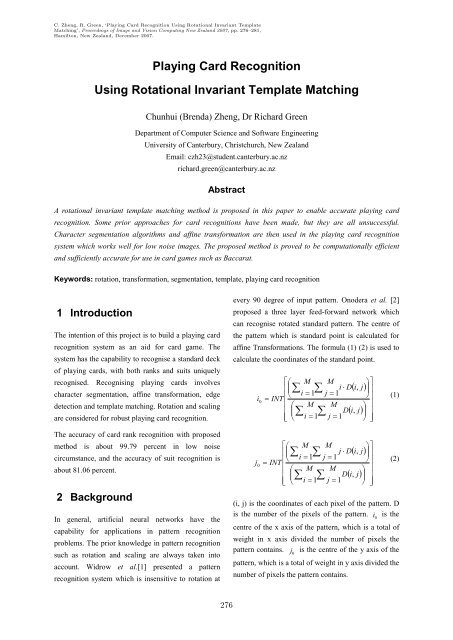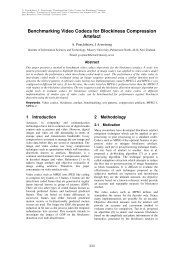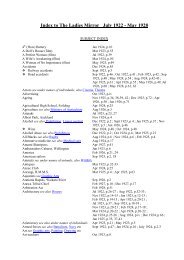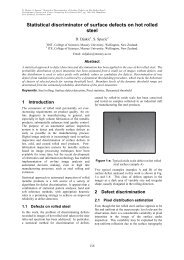Playing Card Recognition Using Rotational Invariant Template ...
Playing Card Recognition Using Rotational Invariant Template ...
Playing Card Recognition Using Rotational Invariant Template ...
You also want an ePaper? Increase the reach of your titles
YUMPU automatically turns print PDFs into web optimized ePapers that Google loves.
C. Zheng, R. Green, ‘<strong>Playing</strong> <strong>Card</strong> <strong>Recognition</strong> <strong>Using</strong> <strong>Rotational</strong> <strong>Invariant</strong> <strong>Template</strong>Matching’, Proceedings of Image and Vision Computing New Zealand 2007, pp. 276–281,Hamilton, New Zealand, December 2007.<strong>Playing</strong> <strong>Card</strong> <strong>Recognition</strong><strong>Using</strong> <strong>Rotational</strong> <strong>Invariant</strong> <strong>Template</strong> MatchingChunhui (Brenda) Zheng, Dr Richard GreenDepartment of Computer Science and Software EngineeringUniversity of Canterbury, Christchurch, New ZealandEmail: czh23@student.canterbury.ac.nzrichard.green@canterbury.ac.nzAbstractA rotational invariant template matching method is proposed in this paper to enable accurate playing cardrecognition. Some prior approaches for card recognitions have been made, but they are all unsuccessful.Character segmentation algorithms and affine transformation are then used in the playing card recognitionsystem which works well for low noise images. The proposed method is proved to be computationally efficientand sufficiently accurate for use in card games such as Baccarat.Keywords: rotation, transformation, segmentation, template, playing card recognition1 IntroductionThe intention of this project is to build a playing cardrecognition system as an aid for card game. Thesystem has the capability to recognise a standard deckof playing cards, with both ranks and suits uniquelyrecognised. Recognising playing cards involvescharacter segmentation, affine transformation, edgedetection and template matching. Rotation and scalingare considered for robust playing card recognition.The accuracy of card rank recognition with proposedmethod is about 99.79 percent in low noisecircumstance, and the accuracy of suit recognition isabout 81.06 percent.2 BackgroundIn general, artificial neural networks have thecapability for applications in pattern recognitionproblems. The prior knowledge in pattern recognitionsuch as rotation and scaling are always taken intoaccount. Widrow et al.[1] presented a patternrecognition system which is insensitive to rotation atevery 90 degree of input pattern. Onodera et al. [2]proposed a three layer feed-forward network whichcan recognise rotated standard pattern. The centre ofthe pattern which is standard point is calculated foraffine Transformations. The formula (1) (2) is used tocalculate the coordinates of the standard point.ji00⎡⎛⎢⎜= INT ⎢⎝⎢ ⎛⎢ ⎜⎢⎣⎝⎡⎛⎢⎜= INT ⎢⎝⎢ ⎛⎢ ⎜⎢⎣⎝∑∑∑Mi = 1M∑i = 1i = 1∑MM∑i = 1∑∑Mi ⋅ D ij = 1MD ij = 1MD ij = 1( , j)( , j)Mj ⋅ D ij = 1( , j)( , j)⎞⎤⎟⎥⎠⎥⎞ ⎥⎟ ⎥⎠ ⎥⎦⎞⎤⎟⎥⎠⎥⎞ ⎥⎟ ⎥⎠ ⎥⎦(1)(2)(i, j) is the coordinates of each pixel of the pattern. Dis the number of the pixels of the pattern. i is the0centre of the x axis of the pattern, which is a total ofweight in x axis divided the number of pixels thepattern contains. j is the centre of the y axis of the0pattern, which is a total of weight in y axis divided thenumber of pixels the pattern contains.276
By using the method proposed by Onodera et al [2],the translation invariant pattern can be obtained byrearranging the elements of original patterns from itsstandard point.Fukumi and Omatu [3] constructed a system which isefficient for use in rotated pattern recognition and alsocan estimate the rotation angle of input pattern.The methods used in above systems are tested to bestable and reliable, but they are complicated to cardrecognition and somewhere have the weakness.Hollinger and Ward [4] built a card recognitionsystem using computer vision for card game blackjack.However, the results of their card recognition systemare not stated clearly.3 Prior ApproachIn order to adjust the rank and suit images to be thesame position as templates placed, an axis, which isformed by the centroid of rank or suit pattern imageand a point on the contour of that pattern which isfurthest from the centroid, is used as benchmark forrotating. The centroid is calculated as⎛ xmin+ xmaxymin+⎜ ,⎝ 2 2ymax⎞⎟first. And then the system⎠calculates the distance between the controid and eachpoint in the contours of the pattern, in order to findthe furthest point. After testing, this method ofcalculating controid is accurate for regular shapessuch as rectangle, but is not good enough for irregularshapes such as the shape of 2.Another method is then applied to calculate thecontroid, which uses the formula (1) (2). This methodperforms well in the calculation of centre point forany shape. After the centre point is determined, theproblem then appears which is difficult to find thefurthest point to the centre point. More than onefurthest point is found for some ranks, such as 8, 6and 9. Therefore, there is no unique benchmark can beused for rotation. This problem could be solved bygenerating much more templates for certain cards.However, more templates mean more comparison formatching, which can lead to slow processing speedand low accuracy. This approach fails consequently.Moving on to another attempt for card recognition,each pattern in a card image is compared withtemplate. There are several patterns in a card image,especially for Jack, Queen and King where manypatterns exist. Therefore, the recognition time isextremely long and this approach has been eliminated.4 Implementation and Methods4.1 Image CaptureA web camera used in the playing card detectingsystem acts as a sensor to scan playing cards. In theprocess of generating templates, the web cameracaptures 13 images, which contain 13 different ranksand four kinds of suits. The resolution of the camerais important. The higher resolution camera is used, thebetter result can be achieved. The web camera used inthis playing card detection system needs to be placedclose to the card.4.2 <strong>Template</strong>s DeterminingThe rank and suit of playing cards need to berecognised. Therefore, 18 patterns with 13 ranks and4 suits are generated as templates; rank 10 isseparated into two patterns 1 and 0. Each templateimage is a smallest rectangle that contains a rank or asuit, which is then resized to 15 × 20 pixels. Thetemplates are separated into two parts: the positivetemplates and the reverse templates. The positivetemplates contain ranks and suits patterns with zerodegree rotation, and the reverse templates contain thereverse patterns of positive templates. Theclassification of the templates could help to reduce thememory cost in the future procedure of comparison.Figure 1:Positive and reverse templates samples4.3 <strong>Playing</strong> <strong>Card</strong> Selection<strong>Playing</strong> card selection involves constructing binaryimage by thresholding grey image. Thresholdingeliminates some noise to a certain extent [5] [6].277
Next, edge detection is used to find contours ofimages. The contours of images are stored in thesequence of a tree. The contours of card are outsidecontours, which are obtained at the first level of thetree sequence. Contours of rank and suit are insidecontours, which can be retrieved in the next level.Figure 2: Finding contoursthe region of interest that contains card to enhance theaccuracy of finding contours of pattern. Fornormalization, the enlarged card images are resized to300 pixels in height, and the width of cards are alsoenlarged correspondingly.4.5 <strong>Card</strong> RotationThe captured image of a card can be in any position inthe background. When doing the comparison withtemplates, cards are rotated to the same position astemplates. Clockwise rotation is applied. As thecoordinates of points in the images are known, theradian of rotating angle can be calculated.To distinguish playing cards from other objects, thesystem looks for the rectangle pattern which containssome inside contours. The polygonal curves ofcontours are approximated with low precision whendoing the calculation to find rectangle shape.Figure 4:Rotation angle of a cardθ is the rotating angle when line P 0line P 1P2. P0( x0,y0), P1( x1, y1), P x2,2( y2are the vertexes of a card, which are known. PointA ( Ax,Ay)lies on line P P , and 1 2AP is vertical to x0axis.0 P 1is shorter than2) and P x , )3( 3y3Ax =x 0(3)Figure 3:Flow chart of playing card segmentationAfter finding the card image, the region of interest isset to a rectangle which contains the card only. TheROI is then enlarger by using bicubic interpolation.The image that only contains card is finally obtainedafter rotating.4.4 <strong>Card</strong> ScalingThe system uses s bicubic interpolation when enlarging( xAy =0− x1)× y2+ (x2−x ) × y 0 1x2− x1(4)By knowing the coordinates of three points P 0, P1and A , we can get the angleθ .After rotating the image, the new width ( w′ ) andheight ( h′ ) of the image is calculated by usingformula (5) (6), wis the original width and h is theoriginal height.h′ = w×sin θ + h×cosθθ (5)278
w ′ = h×sin θ + w×cosθ(6)cosθMatrix =− sinθsinθcosθ0.5w0.5h(7)Equation (7) is a rotation matrix. By multiplying thismatrix, a new image determines. The rotated imagedoes not have the same size as the original image andthe values of pixels at non-integer coordinates areretrieved using bilinear interpolation. [8]4.6 Character SegmentationCharacter segmentation involves card rank and suitsegmentation. For card rank segmentation, the regionof interest is a rectangle which contains the top leftcorner or the bottom right corner of card, wherecontains up to three patterns. Three possible patternsin ROI are rank pattern, the part of the suit pattern andthe part of inside picture pattern. Each possibleobtained pattern is segmented for an image with thesmallest rectangle that contains the contour of pattern.These obtained images are compared with templatesto retrieve the rank pattern of card. For card suitsegmentation, the system captures first ten patternsthat are found in the card. Each of those patterns issegmented for image with the smallest rectangle thatcontains the contour of pattern and then comparedwith templates to retrieve the suit pattern of card.Figure 5:Character segmentation of Queen4.7 <strong>Template</strong> MatchingThe image that contains required pattern as mentionedin character segmentation is resized to 15 × 20before the comparisons. Every pixel of the image iscompared with template. There are several steps forcomparing the resized images with templates torecognise rank and suit of card. First, the obtainedpatterns in the top left corner region of interest arecompared with the positive templates which arementioned in template determining section. If the rankpattern is not found, the obtained patterns in the rightbottom region of interest are then compared with thereverse templates. The rank patterns should be likelyfound through these procedures. If the rank patternsare still not found, the system will try to find them inthe procedure of finding the suit patterns. The suitpatterns normally start to be found after the rankpatterns are recognised. First ten patterns found in acard will be compared with templates to find the suitpattern of card. The card recognition systemdetermines a card based on the degree of match.5 Experiment and ResultsThe playing card recognition system can recognise therank and suit of cards in a dark background. However,the system is only reliable when cards are separatedfrom each other.An experiment has been carried out to test theeffectiveness of the proposed template matchingalgorithm. <strong>Template</strong>s of thirteen different ranks havebeen generated before doing the experiment. Also, 52different cards have been captured by a camera withresolution of 1024 × 768 pixels at a distance of half ameter. The card size is then about 150×200 pixels,and the size of rank patterns is about 15×20 pixels.In the experiment, the playing card recognitionsystem is used for recognising the 52 images afterevery 10 degree rotation, from 0 degree to 180degrees. Then, those images are scaled to 90%, 80%,70%, 60%, 50% and 40% of the original image size.Those images will be recognised after every 10 degreerotation when the size of images is scaled every time.Therefore, each of those 52 cards is recognised for108 times with 6 different sizes.The results of card rank recognition are shown infigure 6. The accuracy of rank recognition is idealuntil the card images are scaled below 60% of originalsize. Figure 7 lists the accuracy of rank recognition279
against the reduction of image resolution for eachrank. Rank 5 has relative low recognition accuracy, asit is always recognised as rank 6.Figure 7:The percentage of accuracy for templatematching against reduction of image resolution foreach rank100.00%80.00%60.00%40.00%20.00%0.00%Rank recognised rate1 0.9 0.8 0.7 0.6 0.5 0.4The card suit recognition results are shown in Figure8. There are three bars which represent the accuracyof suit recognition for thirteen ranks (left side bar),the accuracy of suit recognition for ranks excludingjack, queen, king (bar in the middle) and the accuracyof suit recognition for ranks jack, queen, king (rightside bar). As jacks, queens and kings are traditionallyrepresented by a variety of alternative standardpatterns, they are more difficult to be recognised.Figure 6:The percentage of accuracy for ranktemplate matching against reduction of imageresolution1 0.9 0.8 0.7A 100.00% 91.67% 95.83% 93.06%2 100.00% 100.00% 100.00% 100.00%3 100.00% 100.00% 100.00% 100.00%4 100.00% 100.00% 100.00% 100.00%5 98.61% 79.17% 70.83% 56.95%6 100.00% 100.00% 100.00% 100.00%7 100.00% 100.00% 100.00% 93.06%8 100.00% 100.00% 100.00% 100.00%9 100.00% 100.00% 100.00% 100.00%T 98.61% 100.00% 100.00% 98.61%J 100.00% 87.50% 100.00% 95.83%Q 100.00% 100.00% 95.83% 87.50%K 100.00% 86.11% 90.28% 79.17%0.6 0.5 0.4A 72.22% 75.00% 22.22%2 97.22% 72.22% 34.72%3 100.00% 98.61% 91.67%4 100.00% 91.67% 61.11%5 59.72% 48.61% 2.78%6 97.22% 97.22% 66.67%7 90.28% 94.44% 30.56%8 97.22% 79.17% 33.34%9 100.00% 100.00% 44.45%T 77.78% 26.39% 11.11%J 52.78% 51.39% 16.67%Q 76.39% 76.39% 12.50%K 69.44% 52.78% 37.50%100%80%60%40%20%0%spade heard club diamondwith J, Q, K without J, Q, Konly J, Q, KFigure 8:The accuracy rate for suit recognitionIt is important to notice that the rotation does notaffect the accuracy of recognition in proposed system.According to the results, it is clear that the resolutionof camera is important to the recognition accuracy inthe proposed card recognition algorithm. However,the method is robust to rotation of playing cards.6 Conclusion and Future WorkThe rotational invariant template matching methodproposed in this paper is proved to be computationallyefficient and accurate for playing card recognition.However, noise significantly influences the accuracyof the recognition. Also, the same cards need to beused as the cards generating templates. The systemcannot be generalized to the wide variety of playingcard decks available.280
More works can be done to increase the accuracy ofsuit recognition such as adding a colourdifferentiation method [9]. In addition, a generalizedtemplate and approach for more robust to noise [10]can be developed in the future research [11].Moreover, a new version of this system could includerules for various card games.References[1]. B. Widrow, R. G. Winter, and R. A. Baxter,“Layered neural nets for pattern recognition”,IEEE Transactions on Acoustics, Speech, andSignal Processing, vol. 36, No. 7, July 1988,pp.1109-1118.[2]. Y. Onodera, H. Watanabe, A. Taguchi, N. Lijima,M. Sone, and H. Mitsui, “Transaction androtation-invariant pattern recognition methodusing neural network with back-propagation”,Singapore ICCS/ISITA, 1992, pp.548-552.[3]. M. Fukumi, S. Omatu, and Y. Nishikawa,“Rotation-invariant neural pattern recognitionsystem estimating a rotation angle”, IEEETransactions on Neural Networks, vol.8, No.3,May 1997, pp.568-581.[4]. G. Hollinger and N. Ward, “Introducingcomputers to blackjack: Implementation of acard recognition system using computer vision”.http://www.andrew.cmu.edu/user/gholling/home/IEEEHollinger.pdf, visited on 25/9/2007.[5]. C. Chandra, J. Butala, and S. Patil, “Computervision: Binary image processing”.http://www-ee.uta.edu/Online/Devarajan/ee6358/BIP.pdf, visited on 3/9/2007.[6]. M. Jansen, “Noise reduction by waveletthresholding”, Lecture notes in statistics, vol.161, XXI, 2001, pp.191.[7]. D. A. Forsyth, and J. Ponce, Computer Vision: aModern Approach. New Jersey: Prentice Hall,2003.[8]. Intel Open Source Computer Vision Library.http://www.intel.com/technology/computing/opencv/, visited on 8/9/2007.[9]. P. Montesinos, V. Gouet, R. Deriche and D.Pele,“Matching color uncalibrated images usingdifferential invariants”, Image and VisionComputing, vol 18, issue 9, June 2000, pp.659-671.[10]. A. Rodtook, and S. S. Makhanov, “A filter bankmethod to construct rotationally invariantmoments for pattern recognition”, Patternrecognition letters, vol. 28, issue 12, September2007, pp.1492-1500.[11]. Y. Ding, X. Ping, M. Hu, and D. Wang, “Rangeimage segmentation based on randomized Houghtransform”, Pattern <strong>Recognition</strong> Letters, vol. 26,issue 13, October 2005, pp. 2033-2041.[12]. B. Zitova and J. Flusser, “Image registrationmethods: a survey”, Image and VisionComputing, vol 21, 2003, pp. 977-1000.281







